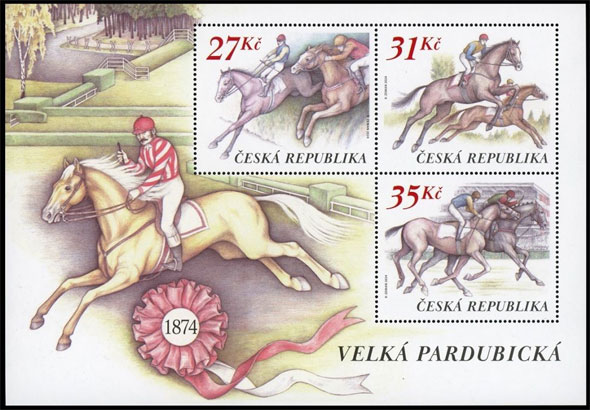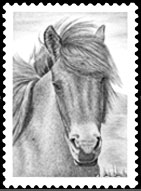
On October 9, 2024, the Czech Post issued a miniature sheet in honor of the 150th anniversary of the Great Pardubice steeplechase.
The Great Pardubice Steeplechase (Velká pardubická) is a true legend in the world of equestrian sports. The unique Pardubice steeplechase track is considered one of the most difficult to pass. Its length is 6,900 meters, during the competition, riders must overcome 31 obstacles. The most difficult of them are the "Big Taxis", "Irish Bench", "Snake Ditch" and "Great Gardens".
The emergence of the Pardubice Steeplechase is closely associated with the name of Count Octavian Kinsky - a famous figure in the history of Czech horse breeding and equestrian sports. Belonging to the ancient noble family of Kinsky, Count Octavian, continuing the family tradition, was actively involved in horse breeding. The Count was a fan of English horse racing and parfe hunting. He became the main promoter of this sport in Bohemia. In 1836, the Count organized the first English-style parforce hunt in Bohemia, and in 1848, the first steeplechase. Inspired by the Great Liverpool Steeplechase, Octavian Kinsky and his son decided to create their own track in their native Pardubice, and in 1874 their efforts were crowned with the Great Pardubice Steeplechase. The first Pardubice Steeplechase took place on November 5, 1874. The track was so difficult that only six out of 14 horses finished.
In honor of the 150th anniversary of the Great Pardubice Steeplechase, the Czech Post issued a miniature sheet of 3 stamps. The famous Czech artist Karel Zeman was invited to create the stamps. He said that he was very happy to receive this assignment. The artist took his work seriously, conducted a thorough study and visited Pardubice to see everything with his own eyes and soak up the spirit of this unique place. Karel Zeman was inspired by history, the fates of people and horses.

The artist managed to masterfully combine history and modernity. The central place on the small sheet is occupied by the historical image of Count Octavian Kinsky on the Pardubice track. Below is a prize rosette with the date 1874 - the year the Pardubice steeplechase was founded, and in the background are various obstacles of the famous track. The three stamps depict the most expressive moments of modern competitions. On the stamp with a face value of 27 crowns, riders overcome the most difficult obstacle called the "Big Taxis". It is a hedge one meter forty high and one and a half meters wide. And right behind the hedge "hides" a ditch, the width of which is four and a half meters! Jumping over the "Big Taxis", the horses fly in the air for thirteen to fifteen meters. The stamp with a face value of 31 crowns depicts this incredible flight of horses over the ditch. And on the last stamp with a face value of 35 crowns we see a gallop on the finish line in front of the stands of the hippodrome. This is how the artist managed to combine space and time, depicting on one sheet a history of 150 years and a racing track of almost 7 thousand meters.

In addition to the small sheet, Karel Zeman also designed three first day covers with individual designs and three special postmarks. The two Pardubice postmarks naturally depict a horse and a horseshoe with a prize laurel branch, but the design of the third postmark from Chlumec nad Cidlinou, I think, requires explanation.

The fact is that in the tiny town of Chlumec nad Cidlinou there is the historical residence of the Kinsky Counts and the famous Czech stud farm "Equus Kinsky", where horses of the same breed are bred. All Kinsky horses have a brand in the form of a coat of arms with a crown, on which three curved "tongues" are depicted. These three curls represent wolf teeth, and a romantic legend is associated with them, which is more than a thousand years old. Once upon a time, the king's daughter and her retinue were hunting in the forest, when suddenly wolves attacked them. The entire retinue ran away in fear - with the exception of one young man, who, naturally, saved the princess, killing three wolves in the process. For this feat, the king knighted the brave young man and gave him a coat of arms depicting three wolf fangs. According to legend, this is how the history of the Kinsky family, one of the oldest and most noble in Bohemia, begins. It is the coat of arms that we see on the postmark.

Incidentally, this is not the first time that the Czech Post has remembered the living gold of the Czech Republic; a series of postage stamps in 2013 was dedicated to the Kinsky horses.
Source: www.ceskaposta.cz
Перейти в каталог
I apologize for any errors or inaccuracies


